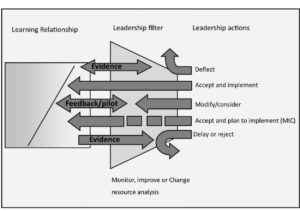Is compliance a disadvantage in leadership?
After some years of being a teacher I had concluded that compliance was a learning disability. One size does not fit all and yet if we accept without question what we are told to learn, to a standard we are directed to achieve and accept the way we are instructed to learn then we are going to be limited in our achievements. This can become a critical situation if the approach we are subjected to does not suit our learning needs. By being compliant we will be expected to conform,and in many situations, we will be subject to regulation if we don’t.
In June 2016 I had the opportunity to ask Sir Ken Robinson at the Festival of Education if compliance was a learning disability. To which he replied ‘No, but it is certainly a disadvantage’. Sir Ken is known for championing creativity in education and in understanding the need to set learning in a much wider context than just reaching a target or building subject knowledge. Creativity is very much about doing things differently, about solving problems, about making mistakes, and learning from them. Being creative is important, perhaps even critical to learning and therefore to teaching.
Can we be creative if we are compliant, will we ever challenge what we are told, will we ever offer an alternative view or strategy, will we ever change anything if we adopt a compliant approach or will we just give others authority over us?
This is a contentious question but what has it got to do with teaching and leadership, Ofsted, the role of a headteacher? First all teachers are learners, and in my view if we stop being learners then we give up the right to be teachers. Second all teachers are leaders, they lead the learning of their pupils and they lead their classes, and they can lead schools. I would go further and say teachers also have a part to play in leading their wider community for they should understand and reflect the needs of the community through what they do in schools.
Where does the true challenge for leadership in our schools lieand should leaders be less compliant?
In HeadsUp4HT’s #8 James Pope said ‘We have to seize our profession back, it’s ours’. This is a sentiment many teachers and headteachers feel and reflects a situation where we have given authority for what we do to others. Whether this was due to being too compliant or not is debatable, I certainly think it is. It is certainly due to not being creative enough in how we have responded to the challenges we face as a profession. Within this article I will show you the mechanism you can adopt for seizing back our profession but first the challenges.
I have a theory about those who become teachers, and it may make you think.
We are motivated to find environments in which we feel safe or comfortable, Maslow recognised this as a basic need. Those that are successful in school are often the compliant learners, we can recognise these easily at report time for it is easy to come up with some suitable comment about continuing to work hard and offer praise for the effort they make. Successful learners tend to continue to study higher level qualifications, and many are guided towards university. In seeking out a career we will tend to find our safe environment once again and for some this is back into the education environment as teachers. The outcome of this process is that many compliant learners become compliant teachers. Not all teachers are compliant and not all successful learners are compliant, but I hope you get the idea behind this theory. The theory predicts that leaders in schools are therefore likely to be compliant by nature and so when instructed rather than evaluating the instruction against a need, capacity, or calculating the value they will tend to execute the instruction.
What happens to those who desire autonomy, the freedom to be creative and be a little less compliant? Well, if teacher recruitment and retention is anything to go by they leave the profession.
Compliance works best as a tool to manage or lead people when there are high risk stakes for not complying and any member of a school leadership team will tell you what those stakes are. In school leadership if you want to maintain a career it is better to be risk averse. Being risk averse often means limiting how creative we are in circumnavigating those things we do not want to do, we weigh one thing up against the other, the risk versus the benefits. The best way to take control of any situation is to be a little less compliant, not obstreperous or belligerent but in a passive and creative manner.
Interestingly mavericks, those that do their own thing are often touted as ideal leaders but the caveat by those in control is so long as they do not step too far out of line. So what can be done about it, how can we take back our profession? The answer is to get creative!
As a design and technology teacher it is not surprising that I see learning as a problem-solving activity and as I also see teachers as both learners and leaders that I view leadership in the same way. A design approach to leadership gives us far more options when it comes to doing the right thing for our pupils, it allows us to get creative.
A simple design model (Figure 1) is not linear and includes several starting or dropping off points making it ideal for monitoring, improving, or changing what we do in schools and for providing evidence, allocating resources and assessing success. Importantly such a model encourages reflection and communication allowing us to learn from both the strategies we adopt and the outcomes we achieve.
Figure 1
My central tenet as a leader is ‘Do no harm’ and putting this at the heart of what we do informs the primary function of a design model approach to leadership. If what we are being asked builds effective learning relationships then do it, if not then get creative is my advice! In my definition of the learning relationship the pupil and teacher are equally important and happy teachers means happy pupils. You can explore more about learning relationships and pupil teacher responsibility in ‘If you can’t reach them you can’t teach them, Building effective learning relationships’, from which the both the figures 1 & 2 used here are taken.
So, in leadership terms what does being creative look like?
Figure 2

Combining the model in figure 2 with a design approach it is easier to actively assess capacity for development or changeas resource analysis is part of the leadership filtering process. Anyone who has been in education for the last 30 years willknow how much change there has been and continues to be and the impact that has on the capacity of their staff to take on anything new. Without the capacity for change, when under stress, we will revert back to learnt and familiar practices as they require less effort to sustain. This makes change difficult if not impossible to embed in an organisation, especially one that is already stressed.
Figure 2 describes my preferred model of a leadership role in schools, placing it between outside influences and the learning relationship providing the ideal opportunities to provide a creative response. This model was developed to show the important role of leadership in schools and confront compliant leadership behaviour in a constructive and creative manner. After exploring any directed policy or new initiative through a design-based approach one of five leadership actions can be determined in response, effectively filtering out those that will not support or benefit the learning relationship. David Hughes has written an excellent book on school culture and creative capacity and is well worth a read.
I do not underestimate the responsibility of these actions or the risks they impose. I have found that any reasoned response with accompanying evidence is a good basis for taking action and difficult to argue against. It also forms an asset when communicating the ‘why’ to those you lead helping in building trust, a key component of leadership.
I have been prompted to share this approach after listening to HeadsUp4HT’s number 8 as it deals with many of the issues and concerns raised in that episode and provides a framework for responding to the challenge James set at the start, that of seizing back our profession. Remember by being compliant we give others authority over us, by challenging what we are asked to do in schools we are establishing a feedback system that can bring about the changes we want to see by providing evidence. Evidence in the form of better pupil/teacher relationships, a more harmonious school environment, and ultimately what we all desire a better education system fit for purpose.
I’ll leave you with some takeaways from session eight and from other discussions and events I have been involved in recently.
References and further reading:
Hewitson, K (2021) If you can’t reach them you can’t teach them. Building effective learning relationships. St Albans: Critical Publishing.
Hughes, D (2019) Future proof your school steering culture, driving school improvement, developing excellence. St Albans: Critical Publishing.
Kell, E (2018) How to Survive in Teaching without Imploding, Exploding or Walking Away. London:Bloomsbury.
Kevin Hewitson
